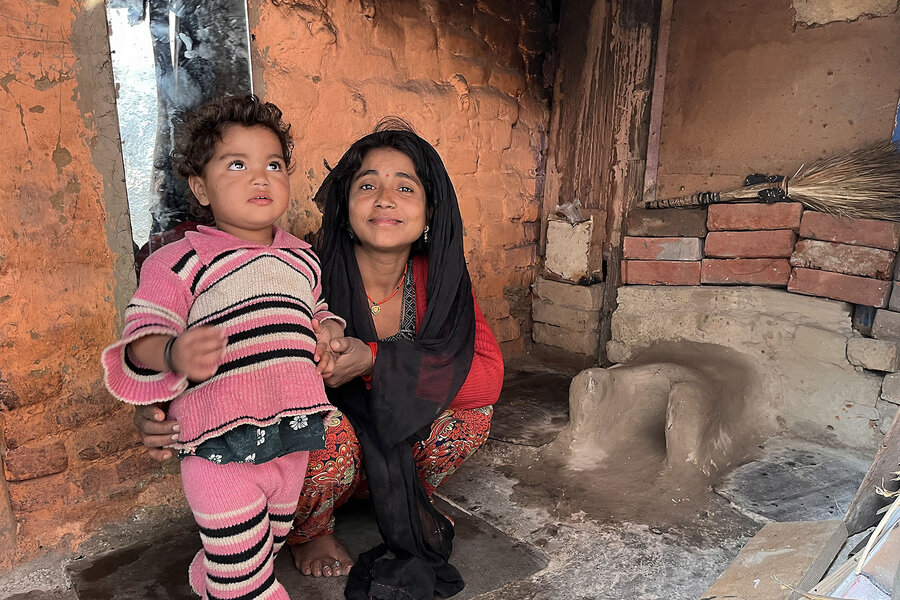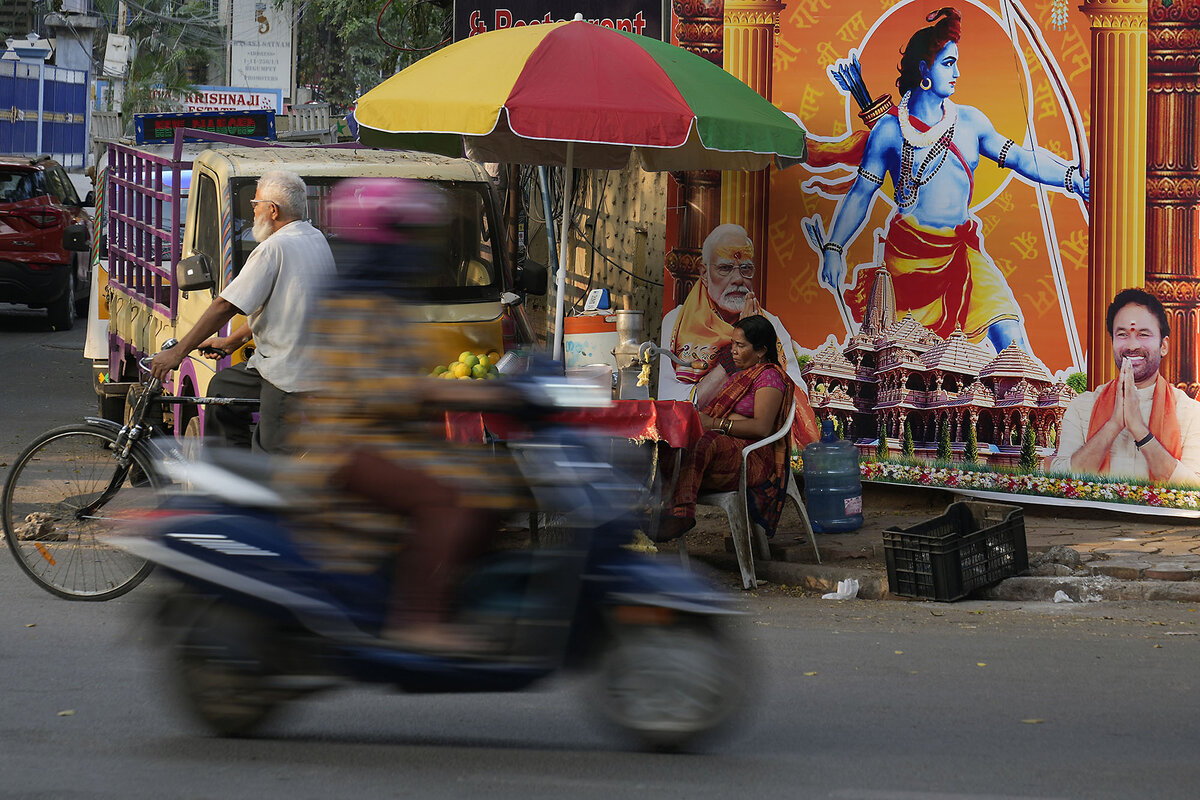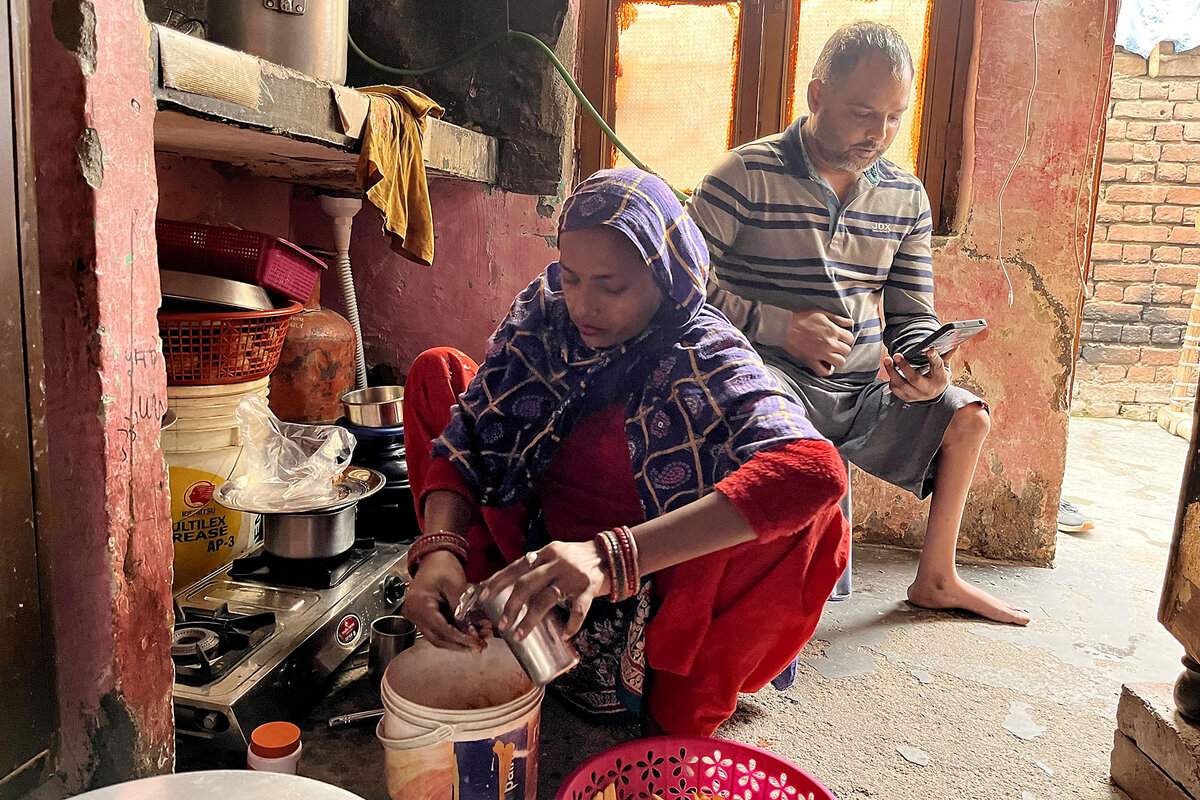Modi’s approach to welfare earns him votes, but does it help India?
Loading...
| Delhi
For years, Kusma cooked on an earthen stove for her family of six. Stirring pots placed over firewood on a short, U-shaped clay structure, she had to inhale toxic smoke that turned the roof of her one-room shanty gray. Until December, when a red cooking gas cylinder and new steel cooktop arrived at her doorstep.
“We felt very good that day; the kids were also happy,” she recalls, keeping one eye on the lunch she has stewing in a pressure cooker.
Kusma, who like many in India goes by one name, is among more than 100 million Indians who’ve received cooking gas connections under one of the federal government’s flagship welfare programs. It’s part of an ambitious welfare agenda that Prime Minister Narendra Modi has rolled out since coming to power in 2014.
Why We Wrote This
A story focused onThe expansion of welfare programs has become a hallmark of Narendra Modi’s government. These initiatives have made a positive impact on the lives of millions of Indians – and earned the prime minister scores of new voters – but some question their long-term value.
Hundreds of programs now deliver benefits – electricity, affordable housing, toilets, and cash – to roughly 950 million people across the country. Late last year, Mr. Modi’s government announced that a program providing free food grains to more than 800 million Indians will continue for five more years.
Coupled with a Hindu nationalist push, Mr. Modi’s populist welfare agenda has helped him expand his support base and will play a key role in general elections, set to begin April 19. Welfare programs are at the front and center of the ruling Bharatiya Janata Party’s (BJP) advertising campaign these days, and opposition parties are taking note, unveiling their own promises.
“This is a free-for-all when it comes to welfare schemes in Indian politics,” says political scientist Sanjay Kumar at the Delhi-based Centre for the Study of Developing Societies.
In a country with high inequality and widespread poverty, “it’s a sign of a healthy democracy that this is what governments would like to compete on,” says Yamini Aiyar, president and CEO of the Centre for Policy Research in Delhi. But Ms. Aiyar and others say the Modi administration’s approach to welfare often falls short. The new programs provide immediate relief, but fail to address structural issues that block the country’s poorest from a path to long-term prosperity.
A unique welfare push
Professor Kumar says the BJP has made “enormous electoral gains” through the expansion of welfare programs. Between 2014 and 2019, the vote share of the BJP increased across all economic classes, but the jump was the highest among poor voters – 12%. While upper-caste Hindus have been traditional supporters of the BJP, new welfare programs have helped the party win over low-caste and tribal voters too, many of whom are poor, he says.
While welfare has always been a part of Indian politics, what is new, according to Ms. Aiyar, is the use of technology. Mr. Modi’s policies have homed in on cash handouts deposited electronically to people’s accounts. The amount of direct cash transferred in 2019 and 2020 was over 28 times the amount in the year before Mr. Modi took office, and the number of beneficiaries in the same period grew sixfold.
The nature of benefits has changed as well, with more focus on providing private goods like cooking gas cylinders rather than on providing public services like health or education, which traditional welfare programs tend to center around, says Ms. Aiyar.
Mr. Modi’s brand of welfare politics is also very personalized. At several metro stations and other public spaces around Delhi, posters splashed with Mr. Modi’s face boast the benefits of his welfare programs.
Gas pumps have selfie points where customers can take a photo with cardboard cutouts of the prime minister alongside a larger-than-life red cylinder. The official names of many programs begin with “Pradhan Mantri,” or “Prime Minister’s,” leaving little room for doubt about whom to give credit.
This form of welfarism, Ms. Aiyar says, shifts the balance of power between citizens and the state.
“Increasingly, we talk about welfare less in terms of rights, but much more in this patrimonial kind of framework where the welfare is being given as a kind of patronage or a charity to the poor,” says Ms. Aiyar. “You’re telling people that they’re just beneficiaries of a program, as opposed to rights-bearing citizens who have full socioeconomic rights that they can demand of the state.”
Short-term relief
Thanks to her new cylinder, Kusma no longer has to go into the forest to collect firewood, nor does she have a coughing fit before every meal. But she worries about the day the gas runs out.
Even at a subsidized rate of roughly $7, a refill costs more than what Kusma’s family, which includes four kids, can afford. Her husband struggles with drug abuse and disappears for days, she says. “Either I’ll have to leave my baby and go to work, or go back to cooking on firewood,” she says. She wants the government to further reduce the cost of cooking gas.
Free food grains or subsidized gas may help people in the short term, Professor Kumar says, but are not “changing their fortunes in the long run.” He says the current welfare policy lacks vision.
Ms. Aiyar agrees, noting that no political party in India has been able to resolve two key issues: a lack of investment in health and education, and limited employment opportunities, which together hinder social mobility.
Santosh Kumar, who lost his job as a quality-checker at an eyewear company during the COVID-19 pandemic, feels this failure acutely.
After struggling for years to find work and surviving on ration kits provided by nongovernmental organizations, he and his wife now sell dumplings by the roadside. They received a loan of roughly $120 under a welfare program for street vendors, but the money is hardly enough to cover his expenses, which include rent, food, school fees for his kids, and the costs to run his business.
“On paper, the government says we have done so much, but in reality what are we getting?” he asks. “The poor are being squeezed from all sides.”
Shortfalls aside, when asked who she will vote for in the upcoming election, Kusma is quick to answer: Modi.








